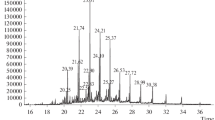Abstract
Pyrolysis fuel oil was heat-treated for 6–8 h at 250–270°C in a stirred autoclave, after which it was separated into the distillate and bottoms by atmospheric and vacuum distillation. The distillate was distilled again to obtain close-cut fractions: prenaphthalene (s.b.–200°C), naphthalene (200–230°C), methylnaphthalene (230–245°C), and residual (245–340°C). The heat treatment led to an increase in the yield and naphthalene content of the naphthalene fraction with a simultaneous decrease in the concentration of unsaturated compounds: mono- and bicyclic alkenes and dienes, vinylaromatic hydrocarbons, indene and its homologs, and dihydronaphthalenes. Naphthalene was isolated from the naphthalene fraction by crystallization and was purified by recrystallization from ethanol. As a result of the heat treatment of the tar, the yield of the purified naphthalene increased by a factor of 2, its melting point increased by 0.4–0.7°C, and the color index on the iodine scale decreased by 18–19 units. After the heat treatment, naphthalene crystallized not only from the close-cut naphthalene fraction but also from the broad distillate taken in the course of primary distillation of pyrolysis fuel oil. In this case, the yield of purified naphthalene was lower by 11.3–27.7 rel %, but its melting point was 0.3–0.6°C higher compared to the isolation from the naphthalene fraction. The highest levels of the naphthalene yield and quality were reached after the heat treatment of the tar at 260°C for 7 h.

Similar content being viewed by others
REFERENCES
Berents, A.D., Vol’-Epshtein, A.B., Mukhina, T.N., and Avrekh, G.L., Pererabotka zhidkikh produktov piroliza (Processing of Liquid Pyrolysis Products), Moscow: Khimiya, 1985, pp. 28–32.
Mukhina, T.N., Barabanov, N.L., Babash, S.G., Men’shikov, V.A., and Avrekh, G.L., Piroliz uglevodorodnogo syr’ya (Pyrolysis of Hydrocarbon Feedstock), Moscow: Khimiya, 1987.
Bednov, V.M., Vol’-Epshtein, A.B., Krichko, A.A., Kechko, M.S., and Yakubovskii, S.F., Khim. Khim. Tekhnol., 1975, no. 9, pp. 98–100.
Patent RU 02136648, Publ. 1999.
Pavlovich, O.N. and Pachin, I.M., Coke Chem., 2011, vol. 54, no. 1, pp. 23–25. https://doi.org/10.3103/S1068364X11010042
Spravochnik khimika (Chemist’s Handbook), Nikol’skii, B.P., Ed., Leningrad: Khimiya, 1971.
Lekhova, G.B., Belousova, O.A., and Chepelevich, A.I., Khim. Prom–st., 1992, no. 1, pp. 9–10.
Leibovich, R.E., Yakovleva, E.I., and Filatov, A.B., Tekhnologiya koksokhimicheskogo proizvodstva (Technology of Coke-Chemical Production), Moscow: Metallurgiya, 1982, pp. 348–353.
Bulavka, Yu.A., Yakubovskii, S.F., Khokhotov, S.S., and Lyakhovich, V.A., Abstracts of Papers, XII Vserossiiskaya nauchno-tekhnicheskaya konferentsiya “Aktual’nye problemy razvitiya neftegazovogo kompleksa Rossii” (XII All-Russia Scientific and Technical Conf. “Topical Problems of the Development of the Oil-and-Gas Complex of Russia”), Moscow: Gubkin Russian State Univ. of Oil and Gas, 2018.
Sokolov, V.Z. and Kharlampovich, G.D., Proizvodstvo i ispol’zovanie aromaticheskikh uglevodorodov (Production and Use of Aromatic Hydrocarbons), Moscow: Khimiya, 1980, pp. 281–294.
Gamburg, E.A., Berents, A.D., Mukhina, T.N., Belyaeva, Z.G., Vinyukova, N.I., and Vol’-Epshtein, A.B., Khim. Tekhnol. Org. Prod., 1981, no. 9, pp. 12–14.
Patent RU 2282609, Publ. 2006.
Patent RU 2557000, Publ. 2015.
Usevich, A.I., Trusau, K.I., Asipionak, E.M., and Kuzemkin, D.V., Tr. Bel. Gos. Tekhnol. Univ., Ser. 2: Khim. Tekhnol., Biotekhnol., Geoekol., 2020, no. 2, pp. 56–61.
Perfil’eva, S.A., Shashok, Zh.S., Uss, E.P., Prokopchuk, N.R., Yusevich, A.I., Kolpakova, M.V., Rusanova, S.N., and Stoyanov, O.V., Klei. Germet. Tekhnol., 2020, no. 3, pp. 21–26.
Petrukhina, N.N., Zakharyan, E.M., Korchagina, S.A., Maksimov, A.L., and Nagieva, M.V., Petrol. Chem., 2017, vol. 57, no. 14, pp. 1295–1303. https://doi.org/10.1134/S0965544117140080
Petrukhina, N.N., Zakharyan, E.M., Korchagina, S.A., Maksimov, A.L., and Nagieva, M.V., Petrol. Chem., 2018, vol. 58, no. 1, pp. 48–55. https://doi.org/10.1134/S0965544118010127
Gluzman, L.D. and Edel’man, I.I., Laboratornyi kontrol’ koksokhimicheskogo proizvodstva (Laboratory Monitoring of Coke-Chemical Production), Moscow: Metallurgiya, 1968.
Nakanishi, K., Infrared Absorption Spectroscopy, Tokyo: Holden-Day, 1962.
ACKNOWLEDGMENTS
The authors are grateful to Cand. Sci. (Chem.) T.N. Genarova (Lykov Institute of Heat and Mass Exchange, National Academy of Sciences of Belarus) for performing measurements by gas chromatography–mass spectrometry.
Funding
The study was performed within the framework of Task 4.3: Development of Technology for Complex Catalytic Processing of Wood-Chemical and Petrochemical Feedstock, Subprogram: Development of New Science-Intensive Domestic Materials Based on Wood-Chemical and Vegetable Feedstock for Various Functional Purposes, State Research Program of Belarus Republic for the Years 2021–2025: Chemical Processes, Chemicals and Technologies, Bioregulators and Bioorganic Chemistry.
Author information
Authors and Affiliations
Contributions
K.I. Trusau: collection of published data, analysis of the raw material, heat treatment of the pyrolysis fuel oil, and isolation and analysis of the products; E.M. Asipionak: atmospheric and vacuum distillation of the pyrolysis fuel oil before and after the heat treatment and analysis of the isolated products; A.I. Usevich: setting of the research tasks, development of the experiment plan, and analysis of the samples by IR spectroscopy.
Corresponding author
Ethics declarations
The authors declare that they have no conflict of interest.
Additional information
Translated from Zhurnal Prikladnoi Khimii, No. 5, pp. 646–655, May, 2022 https://doi.org/10.31857/S0044461822050115
Rights and permissions
About this article
Cite this article
Trusau, K.I., Asipionak, E.M. & Usevich, A.I. Effect of the Heat Treatment of Pyrolysis Fuel Oil on the Naphthalene Yield and Quality. Russ J Appl Chem 95, 707–716 (2022). https://doi.org/10.1134/S1070427222050111
Received:
Revised:
Accepted:
Published:
Issue Date:
DOI: https://doi.org/10.1134/S1070427222050111




